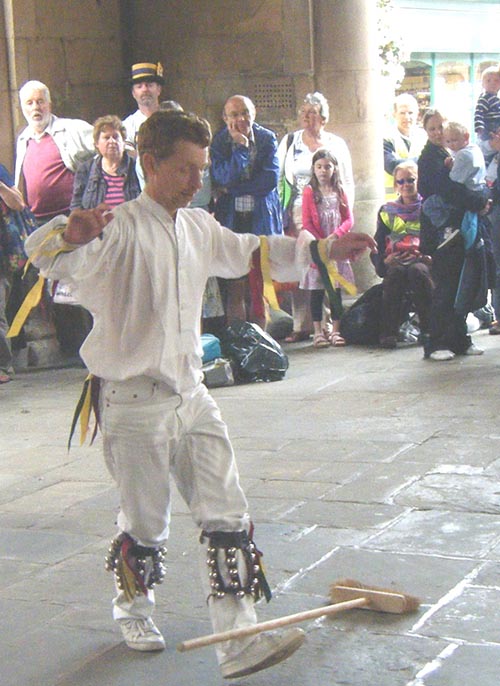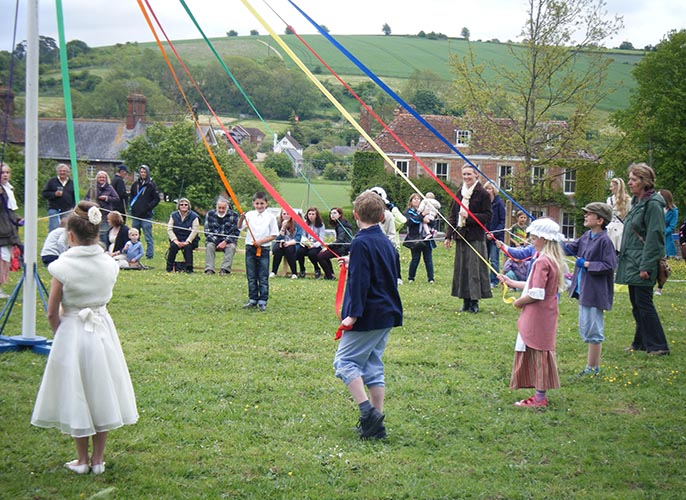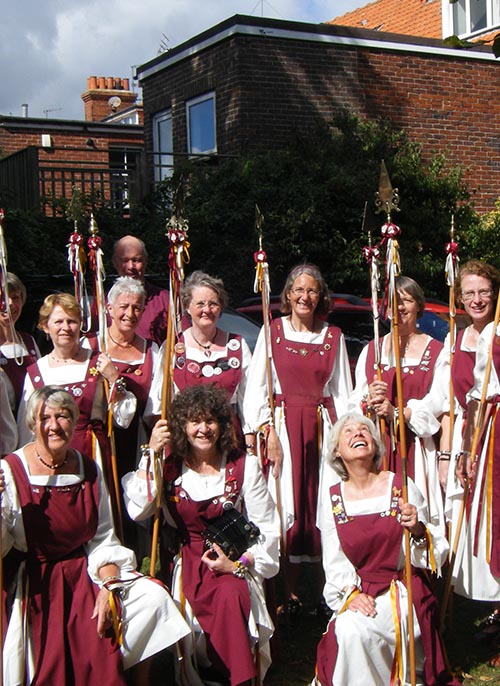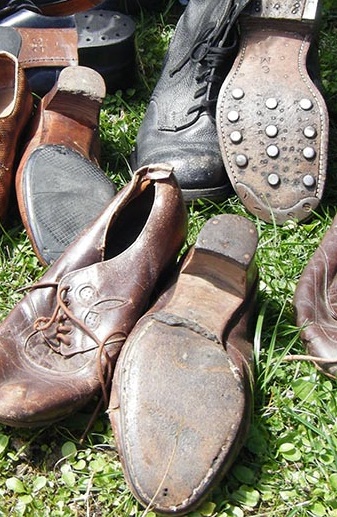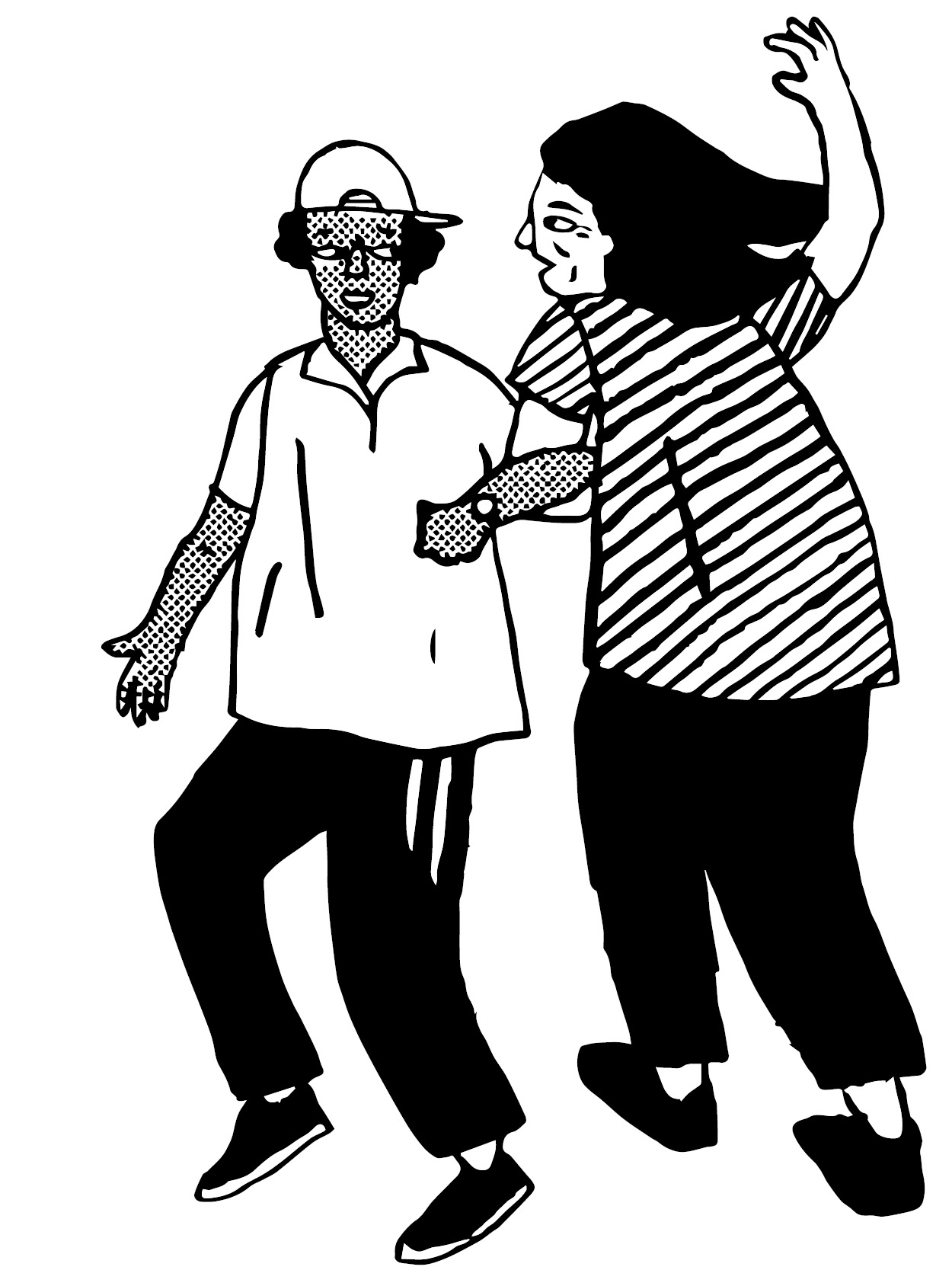Broom, Stave, Maypole and More!
Broom Dancing – Midlands and Southern England
Broom dancing does not have any special costume. It was either performed in morris costume as a solo jig, or in everyday clothing. There are records of farm workers broom dancing in a barn on a wet afternoon and people dancing as an endurance competition to see who could last the longest. In Devon it was performed at weddings into the 1930s by men and women, apparently in their Sunday best clothes. It was a matter of female pride that the women could do the dance as well as, or better than the men, even in their long skirts. Today it is often performed as a solo dance by morris dancers wearing their team costume – although they often take off their bells.
Flag and Bone – Yorkshire
In the 1990s the Flag and Bone Gang revived a tradition from Yorkshire. This was another Plough Monday dance performed in January when there was not much work for people to do on the farms. The Flag and Bone Gang base their choreography on historical references to men dancing in lines holding flags or clicking bones. The new team created a costume based partly on an old picture of the ‘fool plough’ and they attach strips of fabric to their legs. An element of disguise is created through a thin black fabric veil which is attached to wide brimmed hats. The veil gives the performance quite a spooky feel.
Maypole Dancing – Nationwide
Our first records of maypole dancing in England date to the late medieval period. Maypoles reached the height of their popularity in the 1660s, before starting a slow decline. These town and village maypoles were brightly painted, covered in flowers, and very, very, high (up to 27 metres). We have little information about what dances were done around these maypoles. They might just have provided the centre piece for normal social dancing, done in, Sunday best clothing. Maypole dancing was revived in the late Victorian period. Children rather than adults now did the dancing, and often wore pastel or white clothes decorated with flowers. White clothing is now often associated with this style of dance. These costumes probably emphasised innocence, purity, and cleanliness, which were ideas valued by Victorian society. Sometimes themed picturesque costumes were made. If the celebrations had a May Queen then the dancers might be dressed as her followers. Today, if not performed in regular clothes, dancers, especially those putting on a performance, might wear white, or else a specially made historical costume.
Stave Dancing – South West
Staves are a stick with an ornamental end. The end of the stave normally had a symbol. Stave dancing comes from the friendly societies which acted as an early type of benefits system. Members would pay an annual amount and then if they were unemployed, or ill, the society would give them some money to support them. Every year the clubs would have an annual procession and it would normally be an important event for the local area. The members each had a stave and would normally have a friendly society ribbon (often blue) attached to their smartest clothes. The club procession often involved dancing, and this was sometimes done with staves. A number of teams now do stave dancing, either wearing historical costume, or else a modern kit designed to look attractive and be practical for dancing in.
Social Dance – Nationwide
English social dance is also known as barn dance, country dance, and ceilidh dance. Social dances were participatory dancers done by ordinary people. People danced in their homes, in their local meeting place such as a village hall, or outside in the streets. Sometimes it was a special activity with a hired band where people would dress up and wear their Sunday best clothes, at other times it was a spontaneous event, perhaps with someone singing the tune, then people danced in their normal clothes. With the establishment of the English Folk Dance Society in 1911, it became common to perform social folk dances. Members of these classes, and later clubs would wear special costumes to display the dances in. These could be historically inspired outfits, but in the 1950s and 1960s it became popular for men to wear colourful felt waistcoats, and the women large felt circle skirts. Today there are no rules, most people do social dancing in normal clothes, perhaps with sensible shoes or lightweight summer clothes, because the dances can be very energetic. Some women and increasingly also men, also take the opportunity to wear long floaty skirts or dresses.
Step Dancing
Step dancing is a type of dance where the main focus is on the dancer’s footwork rather than their entire body. Step dancers can create many different types of sounds using their feet alone. Different types of step dancing can be found all over the world, examples include tap dance, Irish dance, and clog dance. In East Anglia and Dartmoor step dancing was done in people’s homes, in the pub, and on the street for fun. Some more serious dancers used to travel great distances to dance if they knew that a musician was going to be at a certain pub. Today dancers have special shoes which are comfortable for dancing in or made a good noise when tapped on the floor. Sometimes the dancers make the most of Blakey’s Segs which are a sole and heel protector made of metal. Blakey’s can be attached to the bottom of the shoe, the part which gets the most amount of wear. This makes the shoe harder to wear through and longer lasting. Attached to a shoe, Blakey’s make a distinct clicky sound which is favoured by some step dancers. In competitions today dancers wear normal clothing, although sometimes there is a nod towards the past with men wearing braces and flat caps. Dancers often experiment with different shoe types, and modern tap shoes are sometimes worn.




